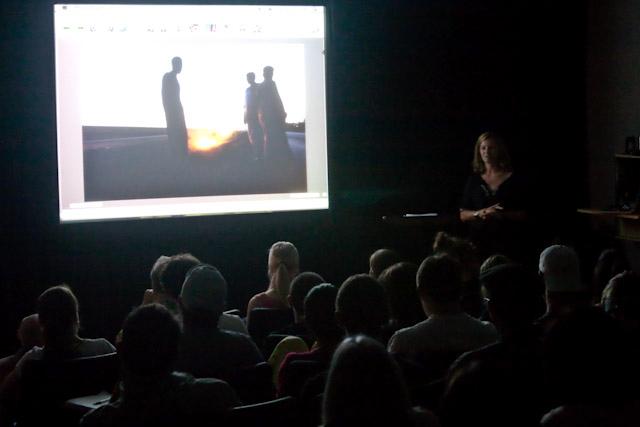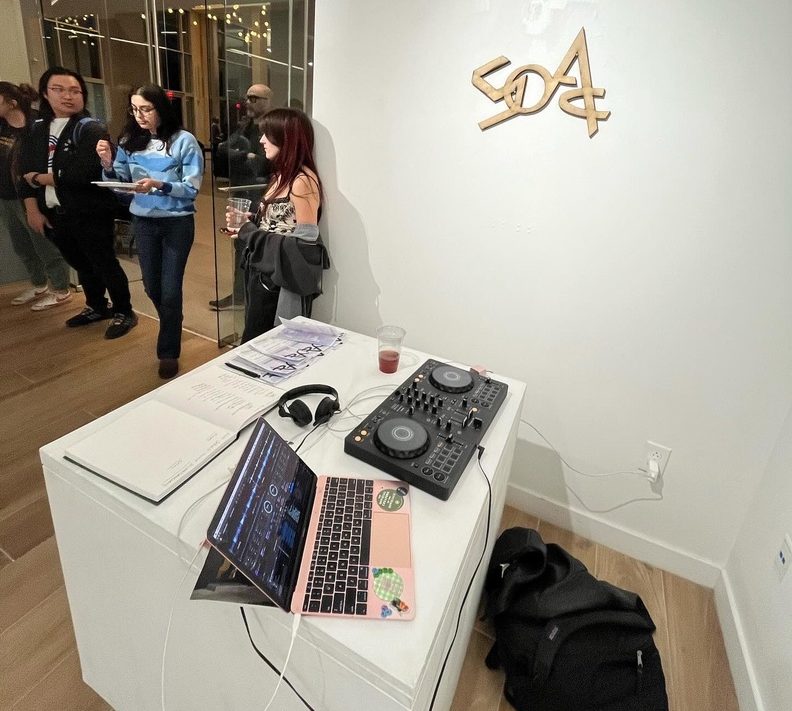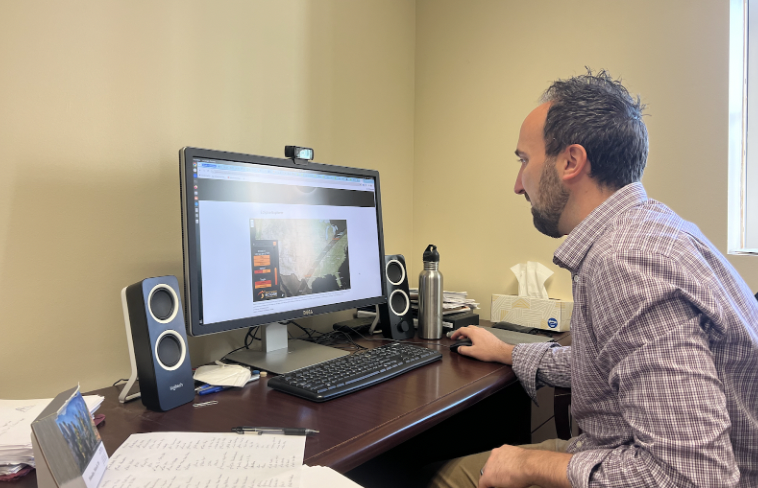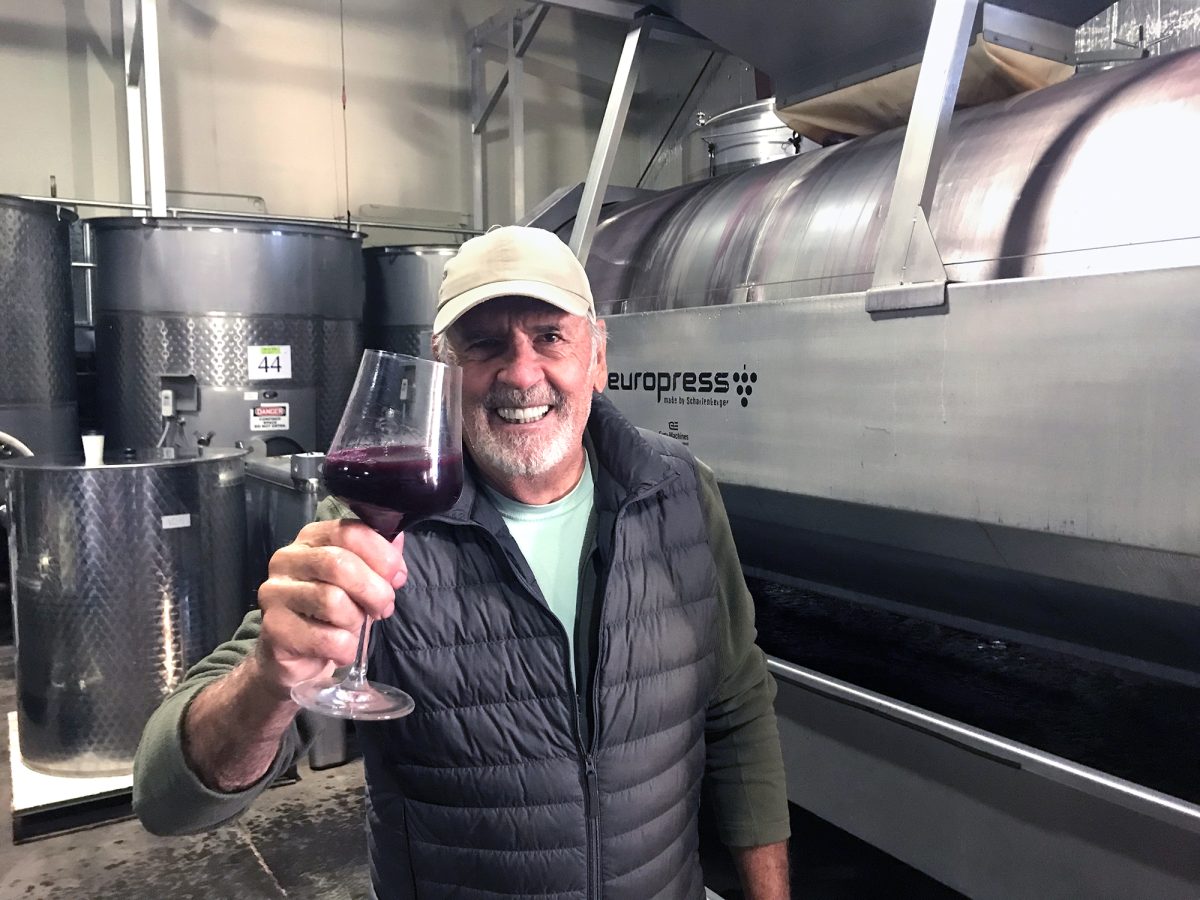
well as the post-Katrina Louisiana coastline. Alford is teaching photography and journalism classes in the Meadows School of the Arts. (Spencer J Eggers/The Daily Campus)
The image being projected on the screen is of a father holding his son. The city in the background looks deserted and dirty, and the street is covered in trash and what looks to be a dark, thick tar. The little boy is looking over his father’s shoulder screaming and is very upset. The father is moving forward with one arm wrapped around his son and the other high in the air.
The next image in the presentation is a picture of a young, dead girl being washed and cleaned for her burial ceremony. There is a woman in a black hijab, sitting in front of a mosaic wall with various patterns, holding the girls body in place.
These are two images photojournalist Kael Alford presented during her visiting artist lecture at Southern Methodist University. They are from her time spent with the people in Iraq, while documenting the U.S. invasion.
“She can casually tell the most horrible stories,” Charlesdee Mitchell, the curator at the McKinney Avenue Contemporary, who worked with Alford during a show she was a part of in May 2011, said. “People listening to her give a gallery talk were really moved and slightly terrified. She can speak very eloquently and she doesn’t romanticize the situation.”
Alford does not typically make a conscious decision to document people’s stories or to always make a personal connection, but she has found it is the best way to get the truest story or information. The majority of her photographs include people in them.
“If I can deal with people in a more intimate way I get a better perspective on a place, I learn more,” Alford. said “I don’t like just skimming the surface of things. I like getting to know how people think about their own situation.”
Becoming a Photojournalist
Alford, who is currently teaching at SMU’s Meadows School of the Arts as a visiting artist and professor, didn’t always know that photojournalism was what she wanted to do. She knew she wanted to be active and travel the world, telling stories and learning as much as she could.
She grew up in the Hudson Valley in upstate New York, and attended a junior college just out of high school. From there she transferred to Boston University where she studied English and anthropology. Once she graduated, she became a corporate temp, but was unsatisfied with the work.
Alford went to graduate school at the University of Missouri to pursue journalism, believing it would be able to satisfy her desire to travel around the world and tell stories.
After taking a photography class, she knew that photojournalism is what she wanted to do.
Her camera became her passport.
Making a Human Connection
Alford moved to the Balkans in 1996 and began working as a photojournalist and reporter. When word came that the United States would be invading Iraq, Alford took the opportunity to get a first hand look of this monumental event.
She wanted to document the war from the beginning, trying to get the real story. This turned into an experience that shaped her career and changed her life.
“I thought the only way to understand those sorts of situations is to see them first hand or to have some direct experience with it,” Alford said.
She got into Iraq a few weeks before the invasion and immediately sank her teeth into the country, befriending some of the local Iraqi’s. Through their trust, she had a firsthand view of the invasion and later, the Iraqi insurgencies.
Some of her photographs are of Iraqi men with guns and heavy artillery and show how close Alford got to these men.
She spent time with the insurgents and gained their trust. She would have lunch with them, spend time in their homes, play with their children, and, over time, if she asked someone to tell her their story they would.
“She is someone who is involved in photojournalism, but also brings and artist eye to it,” Deborah Hunter, a photography professor at SMU, said.
After 2004, Alford did not return to Iraq for a very long time and this bothered her for years, but in the summer of 2011 she took a trip back, returning to a much different Iraq. This time she wanted to relearn the lay of the land and focus on the treatment of Iraqi women.
One of her photographs is an image of a young woman standing in an empty restaurant. She told a story about this single woman, who works as a waitress to feed her two children. Women do not typically work in these kinds of jobs, so the woman is taunted and humiliated everyday by neighbors.
Alford explained that as the woman walks to and from work, they scream at her and call her names such as “whore” causing the woman to worry about her safety and the safety of her children.
Teaching College Students
When Alford’s husband got a job as a photojournalism professor at University of North Texas, she permanently moved to Texas.
SMU offered her a job as a visiting professor for a semester. Alford was a professor while she was living in the Balkans, so she decided to take the job at SMU and get back to teaching.
Alford has one goal for the semester, to open her students up to a world they are not comfortable with and making sure they are leaving her class with some valuable life lessons.
Alford says she finds it very rewarding at the end of the course when students are a little more confident about going into a part of town they aren’t comfortable in or talking to people they wouldn’t normally speak to or even acknowledge.
“Her ability to use real-life examples and share with us her own personal past experiences she has encountered make her lectures very interesting and appealing,” Willow Blythe, one of her current students, said. “You learn a lot more beyond the technicalities of a camera having her as a teacher.”
Along with teaching, Alford continues to work on a current project in Louisiana and would love to be able to dedicate more time to that.
In the near future, she would like to find a story to explore and tell here in Texas. She feels it is her responsibility to tell a story that relates to where she is right now.













